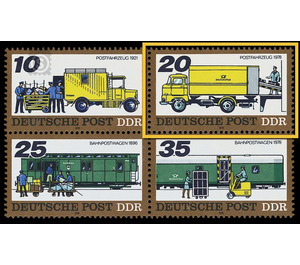Posttransport earlier and today - Germany / German Democratic Republic 1978 - 20 Pfennig
Theme: Post & Philately
| Country | Germany / German Democratic Republic |
| Issue Date | 1978 |
| Face Value | 20.00 |
| Color | brown yellow |
| Perforation | K 13:12 1/2 |
| Printing Type | offset |
| Stamp Type | Postage stamp |
| Item Type | Stamp |
| Chronological Issue Number | 2042 |
| Chronological Chapter | GER-DDR |
| SID | 349711 |
| In 14 Wishlists | |
Posttransport earlier and today With depictions of postal transport in former times and in the present, the Ministry of Posts and Telecommunications of the German Democratic Republic publishes four multicolored special postage stamps in sepa- rate printing as a block of four. Special cancellation from February 9 to April 8, 1978 Every day, Deutsche Post has to transport tens of thousands of mail and small items as well as newspapers and magazines in order to meet the needs of the state, economy and the public, and to safeguard its tasks in the press. These services, which serve the fulfillment of the main task of our socialist economy, must be provided with ever-increasing quality and require the use of a transport system meeting the high demands. The special postage stamps "Posttransport before and today" document that the socialist communications system of the German Democratic Republic has also taken a development that is fully in line with international trends in the area of the postal service. The use of modern technical work equipment in close connection with a rational processing and transport technology in the interests of the involved employees are today the decisive factors of the development, which have replaced an obsolete technology, technology and work organization which no longer correspond to our social requirements. Both on the roads and on the railways of the German Democratic Republic, the scientific and technical progress has been made with large-scale, fast and much better working conditions offering vehicles. Motor vehicles have been used to a noteworthy extent since the 1920s for mailing purposes. Electric vehicles with a very limited radius of action of 50 to 60 km were mainly used for urban transport and parcel delivery service. Today, even at longer distances between cities and service areas, large-capacity vehicles, such For example, we use the W50 trucks, whose performance and reliability are appreciated beyond our borders. In rail transport, the redesigning of the postal service since the early fifties, as well as the significant development of the cooperation partner Deutsche Reichsbahn, has led to the use of ever more efficient railroad post cars, characterized by a concentration of traffic flows and progressive mechanization and partial automation of important processing processes. In particular, the introduction of mechanized cargo exchange with Postgutrollbehältern, of which there are currently more than 14,000 pieces in the operational use of Deutsche Post, has led to significant changes in the design and equipment of the railway mail wagons. Thus, in the holds for the transport of parcels and parcels the packing boards and stack walls were superfluous, while the floors of the car reinforced and rammleisten on the front and side walls and securing devices were to install against unintentional movement of the containers in the transport. The old-style hinged doors, which replaced the charge, were replaced by wider sliding doors. The technically advanced high-performance train rolling stock of the latest production corresponds to the use of state-of-the-art traction means used by the Deutsche Reichsbahn. As the Soviet diesel locomotive type 130, and comes with a possible maximum speed of 140 km / h, the efforts of a constant increase in the speed of fast-traveling trains against. The railway mail van of the year 1978 has a modern power supply and heating system. The installed ventilation and dedusting facilities also comply with the latest scientific findings such as the lighting systems for the individual workplaces in the car. The fact that the railway post office attendants are now also "on the road" a refrigerator is available, is mentioned only in passing. Overall, the employees of the railway postal service are thus offered optimal working conditions. The use of modern motor vehicles and railway mail cars goes hand in hand with the application of highly productive loading and processing technologies. Telescopic conveyor belts and roller conveyors allow a substantial relief of the still common physical work in the loading service. The recent deployment of W50 trucks with tail lift allows even greater use of postal garbage containers in road transport. As a result, more and more technology is being used for this transport process, which has proven its worth for years in rail transport and has resulted in considerable savings in living work. No longer the hustle and bustle of many employees and their manual activities, but the rational use of postal goods roll containers, forklifts and conveyor belts determines the image of the cargo exchange at the means of transport. Thus, the Postal Service also makes a concrete contribution to increasing the quality and effectiveness of socialist communications.


